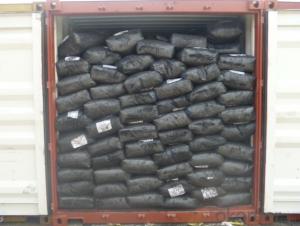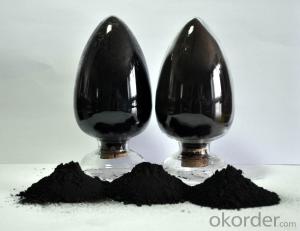Rubber Chemcials Rubber Antioxidant 4010NA
- Loading Port:
- Tianjin
- Payment Terms:
- TT OR LC
- Min Order Qty:
- 25 m.t.
- Supply Capability:
- 12000 m.t./month
OKorder Service Pledge
OKorder Financial Service
You Might Also Like
IPPD 4010NA
Chemical Name:N-isopropyl-N'-phenyl-p-phenylenediamine
Molecular Formula:C15H18N2
Molecular Weight:226.32
CAS NO.:101-72-4
Executive standard:GB/T8828-2003
Specification:
| Index |
| |
Appearance: |
|
Soften Point, ℃≥ | 70.0 |
Loss on drying,% ≤ | 0.30 |
Ash,% ≤ | 0.20 |
Assay(GC),% ≥ | 95.0 |
Properties: Dark brown to purple brown granules. density of 1.14 soluble oils, benzene, ethyl acetate, carbon disulfide and ethanol, gasoline South soluble, not water soluble. Provides powerful and antioxidant properties with excellent high temperature and flex resistance to rubber compounds.
Applications: include the use in pneumatic, an antioxidant for natural rubber and many kinds of synthetic rubber, especially for the prevention of thermal deterioration on NBR. These goods can be used in heated vessels and the Torrid Zone.
Packing :Packed in 20kg or 25kg per bags.
Properties: The product should be stored in the dry and cooling place with good ventilation. The product should be avoid hot sunshine.
- Q: Biological enzymes and chemical catalysts of the differences in the source, nature and catalytic characteristics of the different, specific point
- Biological enzyme catalytic reaction conditions are mild, high selectivity, can not be infected
- Q: Co and No form a chemical equation for Co2 and No2 under the action of a catalyst
- 2CO + 2NO == N2 + 2CO2
- Q: What is catalyst in Science?
- Like everyone told you, catalysts increases the rate of reaction without being consumed. An easy example to think of is mixing natural gas with air --(CH4 + O2). The minute you mix them they are reacting , releasing CO2 as a byproduct and H2O. But they are reacting very slow. But take a match to that slow reaction and it instantaneously reacts with an explosion. In this case the match was the catalyst. It sped up the reaction without adding anything to the reaction or being consumed
- Q: The concept of catalyst in high school chemistry
- Change "has a double meaning, that is," speed up "or" slow down. "Some students believe that the role of catalyst is to speed up the chemical reaction rate.In fact, the catalyst also has positive and negative points, positive catalyst can speed up the chemical reaction rate, such as Enzymes in the human body can speed up the digestion of food and so on; and negative catalyst can slow down the rate of chemical reactions, such as rubber products in the antioxidant.
- Q: What is a catalyst?
- The catalyst itself reduces the energy barrier (Ea, activation energy) of the chemical reaction, making the reaction easier.
- Q: 1. Catalysts can help to bring the reactants together in the correct orientation2. The chemical formula of a catalyst is written on the left hand side (reactant) side of an equation.3. Catalysts can provide a surface on which the reaction occurs.4. Catalysts increase the activation energy.5. Catalysts increase the magnitude of the equilibrium constant, thus favoring product formation.6. "Enzymes" are biochemical catalysts.7. Catalysts increase the rate of a reaction.8. Catalysts are slowly used up during the reaction and need to be replaced.
- 1, 3, 5, 6, 7. 2 is incorrect, catalysts are written above the reaction arrow. 4 is incorrect, catalysts decrease the activation energy thus increasing the rate of reaction (see 7) 8 is incorrect, catalysts are not used up (or if they are, they are also regenerated by a different reaction so that they maintain a constant concentration). edit: about 5, yes i think the answer below is correct, 5 is false actually. catalysts speed up both the forward and the reverse reaction so the equilibrium constant is unchanged. however, 1 is true i think: catalysts can provide a lower energy pathway by way of bringing the reactants together in the correct orientation (rather than random orientations).
- Q: Chemical catalyst in several ways
- Some are composed of oxidative - reduced electricity, such as manganese dioxide catalyzed by hydrogen peroxide decomposition
- Q: It's a GCSE Chemistry questionI just need to know why there are so many
- Many important chemical reactions require inputs of energy to proceed. If a catalyst is present less energy will be required to complete the reaction. Catalysts are substances that are mixed in with materials that are to be reacted, but they themselves do not, in the end, change chemically. They establish a local environment that promotes one or more chemical reactions to take place. A catalyst is important in many industrial processes. Sulfuric acid, which is used to produce batteries, detergents, dyes, explosives, plastics, and many other produces, is commonly produced using a catalyst called vanadium oxide. Ammonia, a primary component of many fertilizers, could not be produced economically without the use of iron oxide which speed up the reaction. The process of catalyst also affects the state of our global environment. Automobiles use catalytic converters to treat exhaust. The metals platinum and palladium facilitate the chemical conversion of noxious gases to more inert forms, greatly decreasing the environmental impact of combustion engines. Probably the most important impact of catalyst is on life itself. All important biochemical reactions are catalyzed by molecules called enzymes. Most enzymes are proteins which catalyze specific reactions within cells. Some examples include polymerases, which synthesize DNS and RNA, peptidases, which digest protein, and ATP synthases, which produce energy for the many different cell activities.
- Q: When you write a chemical equation, how do you want to add "catalyst" and "?" When you do not have to write?
- This is the need for your memory, write a few times, will naturally cooked
- Q: how can you tell when a substance serves as a catalyst?
- It makes a reaction run faster and better AND it is not used up by the reaction
Send your message to us
Rubber Chemcials Rubber Antioxidant 4010NA
- Loading Port:
- Tianjin
- Payment Terms:
- TT OR LC
- Min Order Qty:
- 25 m.t.
- Supply Capability:
- 12000 m.t./month
OKorder Service Pledge
OKorder Financial Service
Similar products
Hot products
Hot Searches
Related keywords
































